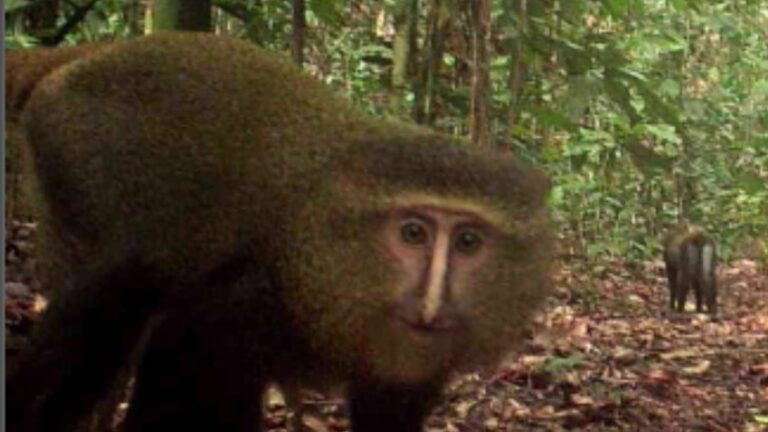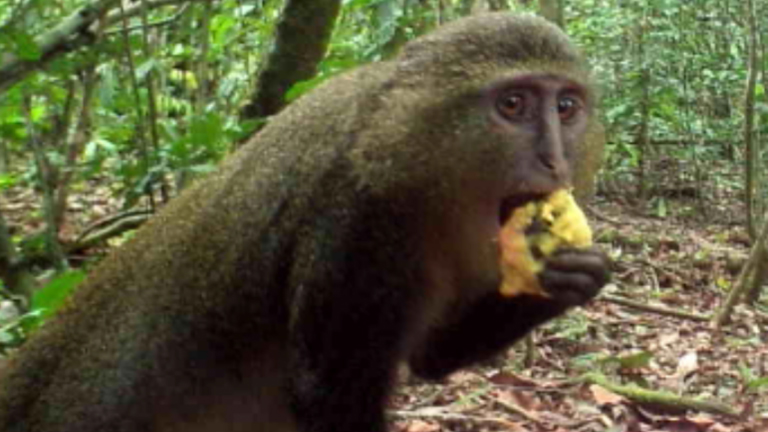Camera traps prove essential in discovering brand new species of monkey
Camera traps have helped identify the second new species of African monkey in 28 years

In 2007, in a humid and remote part of the rainforest in the Lomani Basin in central Democratic Republic of Congo, a team of scientists discovered a brand new species of monkey with the help of carefully placed camera traps.
Now the lesula has become the second new species of monkey to be discovered in Africa in 28 years (after the highland mangabey of Tanzania) – though it was actually first found in far less natural circumstances.
The first encounter scientists had with the species was in the remote village of Opala, when they noticed a little girl with an unusual-looking monkey on a leash. The girl, named Georgette, told the group the animal was called a "lesula", but no one recognized the name or the animal.
The human-like money, which was compared to a Rembrandt painting by the Guardian art critic, became an overnight success with the public. And now, a 2023 camera trap study has proved incredibly useful in finding out more about this animal that has eluded humans for so long.
Unable to track the new monkey using traditional methods, due to the vastness of their 10 million acre habitat and fears of making them overfamiliar with humans, camera traps were essential to the discovery and study of the lesula, and the realization that it was a pretty unique find.
The team set up three camera trap grids between 2013 and 2016, managing to record 15,000 videos, including nearly 600 clips of the lesula.
The traps have revealed that lesulas spend far more time on the ground than other related monkeys in the area, and are also active during the day, living in much larger groups than previously thought.
Get the Digital Camera World Newsletter
The best camera deals, reviews, product advice, and unmissable photography news, direct to your inbox!
The cameras caught nearly 600 clips of them moving around on the floor, compared to only 10 clips of other guenon species. The footage also depicted up to 32 individuals in family groups, composed of a male and numerous females and their young.

Over the past decade, camera traps have proven to be a valuable tool in the study and conservation of endangered species. The first attempts to remotely take photographs in the wild were in 1877, and in 1906 camera trap images were shown to the world when George Shiras published photos of free-living wildlife in National Geographic.
Crucial information about this new species of monkey includes that it is not currently being impacted by hunting. However, when in areas where hunters are active, they move in smaller groups, possibly for that reason.
The footage also raises questions about how the monkeys move around the forest canopy. Another camera trap study is underway to discover more, and potentially unlock some answers about our own evolutionary history.
Study author Kate Detwiler believes the lesula might shed light on "what Australopithecus was doing when it evolved to come down [from the trees]."
Like the lesula, Australopithecus – an early human ancestor that lived some two million years ago – walked on the ground but still climbed trees. "So, if those types of species are living in front of us, we can ask, 'Okay, what are you doing up there?'"
Check out our guide to the best trail cameras, and the best cellular trail cameras, and the best cameras for wildlife photography.

After graduating from Cardiff University with an Master's Degree in Journalism, Media and Communications Leonie developed a love of photography after taking a year out to travel around the world.
While visiting countries such as Mongolia, Kazakhstan, Bangladesh and Ukraine with her trusty Nikon, Leonie learned how to capture the beauty of these inspiring places, and her photography has accompanied her various freelance travel features.
As well as travel photography Leonie also has a passion for wildlife photography both in the UK and abroad.
